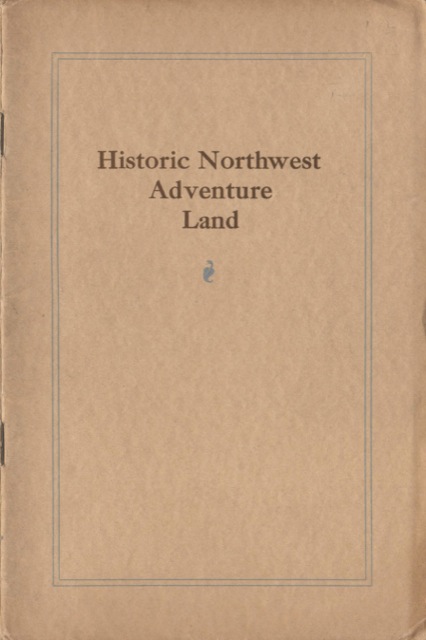After an overnight train trip from Spokane, the expedition arrived in the railroad town of Fallsbridge, Washington, on the Spokane, Portland & Seattle Railway on July 20. Fallsbridge got its name from the Oregon Trunk bridge across the Columbia River which was just downstream from Celilo Falls, which–measured by volume of water–was one of the largest waterfalls in the world until they were flooded by the Dalles Dam in 1956.

The Wishram monument consists of two pillars of columnar basalt rock bound together by iron straps with a small plaque. As a work of art it is considerably more original than an obelisk, but as a monument it fails to draw the eye of train passengers, even those getting on or off the train at the Wishram station 100 feet away. There was once a half-mile trail from the monument to Celilo Falls, where Indians once speared and netted salmon by the hundreds, but the falls were inundated by the Dalles Dam and salmon mostly disappeared with them. Wikimedia commons photo by Williamborg. Click image for a larger view.
However, to mark this occasion, Ralph Budd decided to rename the town Wishram–an Indian word meaning “people who never move,” referring to pictographs on nearby rocks. (Wishram is also the name of a local Indian tribe.) There, they dedicated a monument “To the memory of those dauntless pathfinders and pioneers who followed the great thoroughfare of the Columbia at this place.”
The plaque on the monument lists 43 people who journeyed up or down the Columbia between 1805 and 1841. The stories behind these names tell of the uncertainty over whether Britain or the United States would control the Oregon territory. The first two names are Lewis & Clark, who came down the Columbia in 1805 and returned in 1806, even though everything west of the Rocky Mountain crest was beyond the limits of the Louisiana Purchase.
Next is David Thompson, who came on behalf of the North West Company in about 1808. The next thirteen names on the list–David Stuart, Robert Stuart, Donald McKenzie, Robert McLelan (misspelled; should be McClellan), Donald McLennon, John Reed, Wilson Price Hunt, Ramsey Crooks, Alexander Ross, Gabriel Franchere, Ross Cox, and Alexander Henry–were partners or employees of John Jacob Astor’s Pacific Fur Company seeking to found Astoria on behalf of the United States.
The war of 1812 forced Astor to sell Astoria to the North West Company (and many of the above traders went to work for that company), but a treaty signed after the war provided for joint occupation of the Oregon territory with the understanding that the line between British North America and the United States would be determined later based in part on settlement patterns.

Grace Flandrau’s book provides a travelogue for the entire expedition. Click image to download a 10.8-MB PDF of this booklet. If space or download time is a consideration, you can also download a 2.7-MB version from the Internet archive, which scanned it from the University of Toronto library collection.
At first, the British seemed to dominate. Peter Skene Ogden, John McLoughlin, and George Simpson were with the Hudson’s Bay Company. It was Simpson who encouraged the Red River emigrants mentioned on the Bonners Ferry monument to move to Oregon to help secure the territory for Britain.
Jedediah Smith was an American fur trapper who invaded Hudson’s Bay Company territory, apparently more for fun than for fur collections. Despite the incursion, when Oregon Indians attacked him and killed 15 of his party of 19, John McLoughlin rendered assistance that probably saved Smith’s life. The next two names on the list, David Douglas and Nathaniel Wyeth, along with Thomas Nuttall and John K. Townsend a bit further down, were naturalists who had no political agenda.
The next several names–Jason and Daniel Lee, Cyrus Shepard, P. L. (for Philip Leget) Edwards, Samuel Parker, Pierre J. De Smet, Marcus Whitman, Narcissa Whitman, Henry H. Spalding, Eliza Spalding, William H. Gray, Francis N. Blanchet, Modeste Demars, and Elijah White–were missionaries seeking to save Native American souls. However, some of them, notably the Lees, Shepard, Marcus Whitman, and White, soon decided that securing Oregon for the United States was more important than saving the heathen Indians, few of whom seemed interested in Christianity anyway. So they returned east and encouraged Americans to take the Oregon Trail to the garden of Eden that was the Willamette Valley. Robert Newell, Joseph L. Meek Jesse Applegate, Peter H. Burnett, James W. Nesmith, and John C. Fremont all either led early groups of American over the Oregon trail or were early pioneers who came across that trail.
In 1847, the Whitmans and 12 other people were killed by Indians who suspected them of spreading measles to wipe out Native Americans. This led some of the early settlers to form the first government of Oregon, and–with the support of at least some of the Red River immigrants–that government decided to join the United States instead of Britain. Joseph Meek, one of the most colorful people in Oregon’s early history, made the overland journey to Washington, DC to meet with President Polk (whose wife happened to be Meek’s cousin) asking for U.S. support of Oregon’s provisional government.
While this history is fascinating, one has to wonder why the Columbia River expedition came down the Spokane, Portland & Seattle, Great Northern’s half-owned subsidiary, rather than crossing the Cascades on GN’s own line, which would have allowed the railway to show off the new Cascade Tunnel that was then under construction. The result of this decision was that two of the three monuments designed for the Great Northern for this trip weren’t even on the Great Northern.
One answer is that early European explorers all came down the Columbia River rather than crossing the rugged Cascade Mountains. But another answer is that Ralph Budd’s first association with the Great Northern was assisting John Stevens in managing the SP&S and constructing the Oregon Trunk. From the monument in Wishram, Budd could gaze across the Columbia River and see the Oregon Trunk head up the Deschutes River on its way to Bend.
In any case, the group heard lectures about the Columbia’s history from Harvard maritime historian Samuel Eliot Morison and Portland judge Charles Carey. Carey’s book on early Oregon history had been published in 1922. Titled “The Gateway of the Oregon Country,” his speech in Wishram, as recorded by the Washington Historical Society, was more oratorical than historical.
The SP&S Railway had offered Portlanders an opportunity to take a special train to Wishram and back to attend the ceremony. After dedicating the monument, the trains went to Portland where the group took an auto tour that ended with a picnic at Multnomah Falls (where they could watch trains of the rival Union Pacific go by). They returned to Portland that evening and rode the trains overnight to the Oregon Coast.
